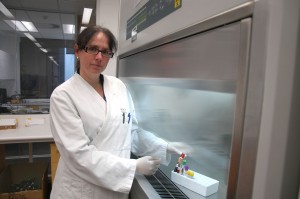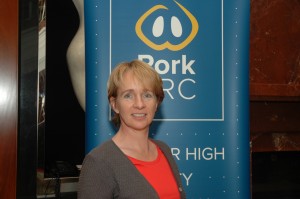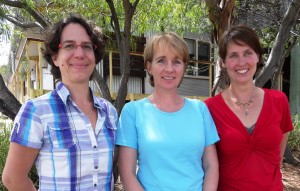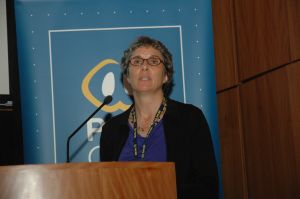Pigs cotton on to rope trick
Dr Deborah Finlaison
Pork CRC Project 2A-108: ‘Evaluation of oral fluid samples for herd health monitoring of pathogens and the immune response in pigs’
After graduating as a veterinarian from the University of Sydney, Deborah Finlaison spent six years as a veterinarian in a practice before commencing as a veterinary virologist in the virology laboratory at the NSW Department of Primary Industries’ Elizabeth Macarthur Agricultural Institute (EMAI).
She completed her PhD in 2010, identifying a new viral disease of pigs (porcine myocarditis syndrome) caused by Bungowannah virus and the next year received the Ralph Hood Award from Animal Health Australia for recognition of “leadership potential and a strong commitment to improve animal health in Australia”. In addition to her diagnostic role in the virology laboratory, Deborah has research interests including diagnosing and controlling viral diseases of pigs.
Oral samples
Interest in the use of oral fluid samples from pigs for disease surveillance has increased exponentially in the past five years overseas. The benefits include easier sample collection, decreased costs for diagnostic testing on a herd basis and the potential for real-time herd health monitoring. Along with her NSW DPI work colleague, Dr Alison Collins, she saw how the use of oral fluids for disease monitoring was expanding overseas and therfore wanted to evaluate this approach for sample collection and disease monitoring for the Australian piggery.
Oral fluid is a mixture of saliva, serum transudate (fluid derived from the bloodstream), inflammatory cells, bacteria, fungi, viruses, bronchial and nasal secretions and food debris. Its usefulness for disease monitoring is because it contains pathogens and antibodies derived from the mouth and blood stream.
Rope trick
Samples are collected by hanging one or more cotton ropes in a pen for 20-30 minutes. Due to the inquisitive nature of pigs, many will chew the rope during the sampling period, after which the rope is collected and the oral fluid squeezed into a container and sent to the laboratory. Pathogens are detected directly (PCR) or by detection of antibodies (ELISA). Unfortunately, oral fluid is not quite as easy to work with as blood. Antibody levels are 10 to 1000 times lower in oral fluid compared to serum. Components of oral fluid can also affect the capacity to detect pathogens by PCR.
Pork CRC Project 2A-108 focused on developing capacity and knowledge on the collection of oral fluid samples and determining storage and transport conditions in Australian environment to provide an optimal sample for detection of pathogens by real-time PCR and antibodies by ELISA.
Deborah and her team also evaluated whether they could detect DNA from porcine circovirus 2 (PCV2) and Lawsonia intracellularis and antibodies in these oral fluid samples. They later looked to see if the level of PCV2 DNA and antibodies in oral fluid correlated with that in blood and if L. intracellularis levels in oral fluid correlated with antibody levels in blood.
They showed that the method of sample handling after collection was critical to give the best chance of detection of pathogens or antibodies. Oral fluid samples need to be placed in a refrigerator as soon as possible and stored in a freezer if not immediately sent to the laboratory. Deborah and her colleagues were able to readily detect L. intracellularis and PCV2 DNA in oral fluid samples and report that it’s likely PCR tests for detection of pathogens will require limited optimisation to be successfully used.
Challenging detection
Antibody detection is more challenging and while they were able to successfully adapt a test for detection of PCV2 antibodies, the low levels of L. intracellularis antibodies could not be detected. Importantly, a good correlation was observed between levels of PCV2 DNA and antibodies in oral fluids and serum and between the L. intracellularis antibody concentration in serum and the number of organisms detected in oral fluid.
While the use of oral fluid samples is being driven by surveillance needs for porcine reproductive and respiratory disease virus (PRRSV) and swine influenza viruses overseas, Deborah and her team believe it is a sampling approach that should continue to be explored in Australia.
Exotic potential
It offers considerable potential for exotic disease surveillance and has been used for the detection of foot and mouth disease and porcine epidemic diarrhea virus. There is capacity to do more real-time surveillance for viruses and bacteria across multiple age groups on a farm which may assist with decision making for timing of vaccination or antibiotic treatment.
For further information, contact Dr Deborah Finlaison by email at deborah.finlaison@dpi.nsw.gov.au
First published in APN Sept 2015
Making Genes Fit
Associate Professor Susanne Hermesch
Principal Research Fellow, Animal Genetics and Breeding Unit (AGBU), University of New England.
Pork CRC Projects 2B-101, 2B-102, 2B-103, 2B-104, 2B-105 in Subprogram 2B – Healthy Robust Pig Genotypes
Since arriving in Australia more than 20 years ago, Susanne has worked with industry to raise the level of understanding and increase adoption of genetic principles and strategies to improve performance of pigs.
Following an ‘apprenticeship’ as a ‘farmer’ and completion of her undergraduate degree at the Georg-August University, Göttingen, Germany, Susanne completed a PhD in quantitative genetics at The University of New England. The PhD project produced the first set of genetic parameters for reproduction, performance, carcase and meat quality traits in Australia. These were subsequently used by industry.
Since then, Susanne has investigated a wide range of topics relevant to genetic improvement of producing pork, in collaboration with leading Australian pig breeding companies.
She has established an extension and adoption framework to foster adoption of genetic principles. Information about research outcomes is available from AGBU’s pig genetics web pages at http://agbu.une.edu.au/pig_genetics/index.html.
International collaborations
Susanne leads a number of national and international research collaborations to develop selection strategies for robustness and disease resilience.
Consistent performance
Robust pigs are able to perform more consistently across a range of environments. Pork CRC Project 2B-101 established that environmental conditions varied considerably, even on farms with good health and management practices. For example, environments differed by about 150 g/day for growth and by more than 6 mm for backfat across herds. Most of this variation in environments was also observed within herds. It was then established that breeds or progeny of sires differed in their response to environmental variation. These results offer opportunities to select for less sensitive genotypes in purebred herds, an outcome that is currently being investigated further.
New models
Economic models were developed in collaboration with Dr Peter Amer, AbacusBio, New Zealand, to establish new breeding objectives for maternal and sire lines (Pork CRC Project 2B-102). It was shown that maternal genetic effects, which represent the genes of dams, were the second most important trait in maternal breeding objectives. This finding is significant because maternal genetic effects do not require any additional investment in data recording by breeding companies. Further, post-weaning survival was identified as the economically most important trait for sire lines. This trait has not been investigated in detail yet despite the fact that information about survival post weaning is available on most farms. Genetic analyses of post-weaning survival will lead to genetic models that enable breeders to include this important trait in their selection decisions.
A key aspect of these economic models is their simplicity, because economic benefits of improving each trait by one unit are derived via independent sub-models. For example, the economic value for feed conversion ratio ($/pig to improve FCR by 1 kg/kg) is simply feed price ($/kg) times live weight (kg). These models are very simple for most traits and can be adopted easily.
Disease resilience
Genetic improvement of disease resilience leads to genotypes able to maintain productivity when challenged by infection. This topic was discussed at a workshop in Armidale as part of Pork CRC Project 2B-103 and led to the publication of a book, Breeding Focus 2014 – Improving Resilience, which was co-edited by Susanne. A keynote speaker at the meeting was Dr Andrea Doeschl-Wilson from Roslin Institute, University of Edinburgh, Scotland, who works with Susanne on developing genetic models for disease resilience and its underlying mechanisms, disease resistance and disease tolerance.
Research collaborators Dr Hélène Gilbert INRA, France, Assoc Prof Susanne Hermesch, AGBU, University of New England, NSW and Dr Andrea Doeschl-Wilson, Roslin Institute, University of Edinburgh, Scotland.
Robust productivity
Evaluating the consequences of selection for feed efficiency on robustness and developing practical selection strategies that lead to more consistent performance of pigs across environments is the emphasis of collaborative research with Dr Hélène Gilbert from INRA, France as part of Pork CRC Project 2B-104. Hélène investigated the response of divergent selection lines selected for residual feed intake to variation in environmental conditions. It had been believed that selection for efficiency and productivity had unfavourable consequences for robustness. However, contrary to expectations, the low residual feed intake line, the more efficient line, was less sensitive to variation in environmental conditions for growth rate. These findings indicate that more efficient pigs may be able to derive nutrient resources more efficiently to face stresses when needed. Further, it raises the question of whether the resource allocation theory is too linear compared to real physiological process.
Alternative selection strategies for the new breeding objectives developed in the previous Pork CRC project are currently being investigated. The breeding objective sets the direction for genetic improvement of pigs by multiplying the estimated breeding value (EBV) of each trait with the corresponding economic value. Economic values are also known as marginal economic values because they quantify the change in profit due to changing a trait by one unit, while keeping all other traits in the breeding objective constant. As such, economic values are essential for genetic improvement, however economic values can also be used to evaluate the economic implications of changing a husbandry practice. Susanne outlined these aspects to industry in a recent series of webinars about PigEV, which were well received by participants.
Fostering adoption
Susanne conducts her research in close collaboration with Australian breeding companies. Therefore, the research itself is part of the adoption process. Genetic gains achieved in purebred populations in traits describing productivity, robustness and survival will eventually be passed on to the commercial level.
Outcomes from these projects have been extensively published at industry events, conferences and scientific journals. Publications and further information about PigEV, which is available to Australian pig producers, may be obtained from Susanne, Email Susanne.Hermesch@une.edu.au or Tel 02 6773 2055
First published in APN April 2015
Ward Working on Weaning E coli Worry
Professor Michael Ward
Project 2A-106: A comprehensive risk factor analysis of Postweaning E.coli disease in Australian piggeries
Professor Michael Ward leads Pork CRC Project 2A-106, ‘A comprehensive risk factor analysis of postweaning E.coli disease in Australian piggeries’, which commenced in late 2012, with PhD student Lechelle Van Breda joining the project in mid-2013. Research Associate Dr Om Dhungyel, an experienced microbiologist, co-supervises Lechelle.
Michael is Chair, Veterinary Public Health & Food Safety within the veterinary school at The University of Sydney and is based at its Camden campus.
After graduating as a veterinarian in 1986 at the University of Queensland, Michael joined Queensland DPI as a government veterinary officer at Townsville, where he undertook general disease control activities, was involved in the brucellosis and tuberculosis eradication campaign and supervised livestock export testing. He simultaneously completed a Masters degree at James Cook University. In 1991 he moved to the USA for PhD studies in epidemiology at the University of California’s Davis campus.
Following his PhD, he returned to Queensland DPI and worked on sheep diseases. He moved again to the USA in 2000, first to the veterinary school at Purdue University, Indiana and then in 2004 to the veterinary school at Texas A&M University.
Feral fear
In 2008, Michael commenced his current position at The University of Sydney, where he has led a number of projects that focus on infectious disease control and biosecurity. These include a project assessing the risk of feral pigs as a reservoir for exotic diseases such as Classical Swine Fever and Foot-and-Mouth Disease and assessing the risk of an incursion of Porcine Reproductive and Respiratory Syndrome (PRRS) virus. All three diseases would have devastating effects on Australian pig herds. The threat of disease spread posed by feral pigs has long been a concern to the industry.
Coli concern
As many pig producers have experienced, E.coli disease causes substantial production losses in weaners and suckling pigs. It is a multi-factorial (many causes) disease with complex risk factors and triggers, but these are poorly understood. It seemingly occurs without warning and can have devastating effects on animal health, welfare and profitability. It is one of the most common problems faced by pig producers. Nutrition, genetics, climate, hygiene, husbandry and weaning practices probably all play a role in this disease.
Beside these negative effects, E.coli disease is also responsible for substantial use of antibiotics. In general, pens of piglets with postweaning scours will be treated with antibiotics in the feed or in the water. The use of antibiotics in agriculture is increasingly becoming a concern to regulators and the public. Excessive or inappropriate antibiotic use in humans or animals can lead to the development of resistance, which compromises health care. Of importance is the risk that antibiotic resistance can potentially be spread to humans via the food chain e.g. if pork consumed contains bacteria with these antibiotic traits then that can cause resistance infections in the consumer, or suboptimal response to antibiotic therapy later when this person is infected by other pathogenic bacteria.
Resistance role
Although the role of antibiotic use in food-producing animals on antibiotic-resistant infections in humans is unclear, there is general agreement that responsible use of antibiotics in agriculture is desirable. Recently, a draft discussion paper, Developing a National Antimicrobial Resistance Strategy for Australia, was jointly released by the Commonwealth Departments of Health and Agriculture. This signals the importance now being given to the issue of antibiotic resistance.
Michael’s current Pork CRC project on postweaning E.coli disease seeks to understand why disease occurs in some herds regularly and in others rarely. The approach is to focus on a variety of herds in south-eastern Australia and characterise the E.coli that infects pigs – both sick pigs and pigs that are clinically normal. Information on the husbandry practices used in these herds is being collected, as well as their antibiotic use. All of this information will be combined to identify what key characteristics and practices lead to postweaning E.coli disease. So far, 25 herds stretching from Sydney to Adelaide have been sampled and thousands of isolates of E.coli bacteria have been grown, characterised and stored. Testing of these for antibiotic resistance has recently commenced.
Farm tool
With a good understanding of the risk factors responsible for postweaning E.coli disease, the next step is to determine how these risk factors are inter-related and what are the critical pathways leading to disease. Ultimately, the vision is to develop a tool (such as a simple scoring system) that can be used on-farm to characterise the risk of disease occurring and which areas of farm management need to be improved to prevent the disease.
Contact: Prof Michael Ward, Email michael.ward@sydney.edu.au
First published in APN Dec 2014
CRC backs CSIRO ETEC attack
Sharon Bishop-Hurley
2C-106: Targeting of E. coli cell surface receptors using phage-displayed peptides
Finding alternatives for antibiotics for the control of Enterotoxigenic Escherichia coli (ETEC) has been the focus for 14 months of Pork CRC research by Dr Sharon Bishop-Hurley at the CSIRO Food & Nutrition Flagship, Coopers Plains, Brisbane.
ETEC is one of the major causes of weaning and post-weaning diarrhea in young piglets, with most piggeries needing to rely on antibiotics for its control. However, the emergence of antimicrobial resistance in ETEC is making it more difficult for piggeries to control this pathogen by conventional means. A focus of Pork CRC Subprogram 2C, Replacement of antibiotics with effective integrated health strategies, is to develop alternate measures for controlling this pathogen in piglets.
Novel approach
The overall aim of Sharon’s project is to develop novel pathogen-specific peptide antimicrobials for the targeted control of E. coli in piglets, replacing the antibiotics that are currently being used. These therapeutic antimicrobials are being isolated from large libraries of peptides displayed on a bacteriophage coat protein (phage-display). Protein and other molecules on the cell surface of bacteria such as E. coli represent novel targets for new peptide drugs because of the role that these cell surface epitopes/receptors play in colonising and persisting in the host gastrointestinal tract. Sharon was originally part of a team in the United States that developed the whole cell phage-display technology currently utilised in this project for the discovery of such anti-bacterial targets in ETEC.
ETEC specific
During the past 30 years, most of the antibiotics developed have been analogues of pre-existing compounds, with few new bacterial targets being discovered by conventional means. Peptides isolated using the phage-display technologies usually bind to ‘novel’ receptors/epitopes on the bacterial surface, thereby disrupting their function. These peptide antimicrobials are not considered the same type of antibiotics used in human medicine because they target different bacterial receptors/epitopes. Importantly, this delivers benefits to the pork industry because of the concern over the use of human antibiotics in food animals. Because the peptide antimicrobials are likely to be specific to ETEC, they will not upset the natural balance of the gastrointestinal microflora of piglets.
ACE result
The phage-displayed peptides isolated in this project have shown antimicrobial activity towards E. coli using in-vitro assays. Earlier this year, ACE Laboratories kindly supplied the E. coli virotypes used in our proof-of-concept antimicrobial assays. These virotypes were originally isolated from piggeries around Australia. Our candidate phage peptides demonstrated antimicrobial activity towards these 50 virotypes. Some of these phage peptides also demonstrated high binding to these virotypes, using a laboratory method known as enzyme-linked immunosorbent assay (ELISA). These same phage peptides were not antimicrobial towards other bacterial species tested, confirming their E. coli specificity.
We are now in the process of synthesising the corresponding monomeric peptides of the phage peptides and testing them for antimicrobial activity. In ongoing assays, we have shown that some of these synthesised peptides can inhibit biofilm formation of E. coli. Ongoing research by Sharon will focus on the delivery of these peptides into piglets.
Contact details: Dr Sharon Bishop-Hurley, email Sharon.Bishop-Hurley@csiro.au.
First published in APN August 2014
Collins class attack on ileitis
Alison Collins
2C-102: Strategies to quantitatively measure and reduce the load of Lawsonia in commercial herds.
2A-109: Assays to measure gut health in order to identify risk factors and control strategies for E.coli scours in weaner pigs.
Finding alternatives to antibiotics for the control of common pig diseases has been the focus of eight years of Pork CRC research by Alison Collins and her colleagues at the Elizabeth Macarthur Agricultural Institute, NSW Department of Primary Industries (NSW DPI).
Alison has worked closely with veterinarians servicing pork producers and pharmaceutical and feed additive companies to find alternatives to antibiotics for the control of pig intestinal diseases.
After training as an agricultural scientist at La Trobe University, Alison worked in vaccine development at CSIRO, then in pig health a few years later, working at the Bendigo Veterinary laboratory, before commencing a PhD at the University of Sydney with Professor Robert Love.
“Working with Bob was a highlight of my career, because he provided an exciting environment where questions and new ideas were encouraged and the research was directly related to pig industry needs. I’ve tried to create and encourage a similar research environment for my own students since then,” Alison explained.
Production limiting
Her research has primarily focussed on controlling the production limiting disease ileitis, which remains one of the main reasons for antibiotic use in grower and finisher pigs in Australia. A common and significant disease, ileitis results in reduced profitability, due to increased medication costs, reduced feed conversion efficiency (FCE), reduced average daily gain (ADG) and an increase in days to slaughter. In collaboration with the University of Sydney and Boehringer Ingelheim, Alison and her team used a CT scanner and production data to quantify the cost of ileitis in Australian herds. Based on a scenario where 80% of pigs were sub-clinically affected in a herd (found in a 2010 Australian survey), net revenue was reduced by $8.33 per pig (AusPig modelling).
CRC research
Her Pork CRC funded research has also focussed on developing management strategies to reduce the survival and transmission of Lawsonia intracellularis, the bacterium that causes ileitis. Cleaning and disinfecting pens are critical in reducing the bacterial load in the piggery and therefore reducing disease severity, because Lawsonia can survive in empty pig pens for at least two weeks. Preventing ileitis also relies on rodent control around piggeries, as rats trapped on pig farms excrete very large numbers of Lawsonia.
Alison’s recent research is developing a cost-effective tool for producers and veterinarians to evaluate their ileitis control treatments and help avoid the associated losses in profitability caused by ileitis. A quantitative assay was developed to measure the number of Lawsonia bacteria shed in pig faeces. In experimental studies, Lawsonia numbers were strongly associated with other measures of ileitis, including reduced growth and damage to the intestine. This quantitative test has since been modified to accurately quantify bacterial numbers in pooled faecal samples, as this will be a more cost effective way to monitor ileitis on farm.
Support team
Support from Australian pork producers has recently enabled the team to quantify the impact of high and low numbers of Lawsonia bacteria on ADG and FCE over a wide range of commercial production conditions. Stephen Heavener, graduate trainee with NSW DPI, has been working with Alison and the research team at Rivalea to identify the critical number of Lawsonia that causes production losses on commercial farms by correlating production measures with bacterial numbers. Stephen’s analysis shows that Lawsonia numbers correlate well with average daily gain when pigs are affected with ileitis. The relationship is not as strong when ileitis is being well managed.
Producer benefits
So, how will this research benefit producers and their costs of production? According to Alison, this study will show producers that once the number of Lawsonia exceeds a certain threshold, pig growth will be compromised and treatments are needed to control disease. For example, we already know from experimental studies that pigs lose 131 grams a day when Lawsonia numbers increase from 10 million to 100 million. If severe infection lasts for seven days, that equates to nearly one kilogram of lost weight per pig, with greater consequences caused by more severe or prolonged infection.
We’re hoping to have the new quantitative Lawsonia test available to pork producers and veterinarians later this year. Questions regarding this research should be directed to Alison Collins at NSW DPI – alison.collins@dpi.nsw.gov.au .
First published in APN Apr 2014
Tom Riley
After 15 years working in diagnostic laboratories and completing a PhD part-time at The University of Western Australia (UWA) in 1984, Tom did post-doctoral studies in the Anaerobe Reference Unit of the Public Health Laboratory Service in England and then in the Division of Infectious Diseases at Johns Hopkins University in Baltimore, USA.
He returned to Australia in 1987 and was appointed Senior Medical Scientist in Charge of the Department of Clinical Microbiology at Sir Charles Gairdner Hospital in Perth in 1988.
In 1993-94, he did a Masters degree in Applied Epidemiology at the Australian National University and in 1995 was appointed Associate Professor, Department of Microbiology at UWA and Principal Research Scientist at the Western Australian Centre for Pathology & Medical Research, now PathWest Laboratory Medicine. In 2002, he was awarded a Personal Chair at UWA.
Tom is a Fellow of the Royal College of Pathologists, Australian Society for Microbiology, American Academy of Microbiology and Faculty of Science of the Royal College of Pathologists of Australasia and has published almost 300 book chapters and refereed journal articles. He has had a long interest in healthcare related infections, particularly the diagnosis, pathogenesis and epidemiology of Clostridium difficile infection (CDI), and started working on CDI in companion animals over 20 years ago.
2A-104: Evaluation of diagnostic tests to detect Clostridium difficile in piglets
C. difficile is a Gram-positive spore forming bacterium and a well-known enteric pathogen of humans. Indeed, it’s the most common cause of infectious diarrhoea in hospital patients world-wide, costing the US healthcare system an estimated US$3 billion annually.
Recently, major CDI outbreaks have occurred in North America and Europe and there has been an increase in disease in the community. Outside Australia, C. difficile is now emerging as a significant issue in livestock such as pigs and cattle, as well as horses and poultry.
In the USA in the early 2000s, C. difficile was reported as a major cause of high-morbidity enteritis and pre-weaning scour in neonatal piglets aged 1-7 days, with outbreak-associated mortality up to 50%. Piglets that recover from CDI can be 10-15% underweight and take longer to wean.
Investigations in the UWA/PathWest laboratory have confirmed that toxigenic C. difficile is present in many pig herds in Australia. C. difficile prevalence in Australian piggeries is as high as 70%, potentially presenting a significant economic issue to the pork industry.
To understand the role of C. difficile in pig disease it’s essential to be able to detect the organism in a timely and cost-effective manner. Unfortunately, many veterinary laboratories in Australia have limited experience with this fastidious organism.
Few of the commercially available methods for detection of C. difficile in humans have been validated for animals and none with the molecular types of C. difficile found in Australian piglets.
This was the basis for my recently completed Pork CRC project 2A-104, the work for which was undertaken by Dan Knight, with the assistance of Michele Squire, who is completing a PhD on CDI in pigs.
The project aimed to guide the pork industry, veterinarians and veterinary diagnostic laboratories on the suitability of currently available commercial assays to detect C. difficile in Australian piglets.
To achieve this we evaluated the performance of four commercial assays to detect C. difficile in 157 specimens of piglet faeces obtained from neonatal piglets (49 scouring) aged less than 14 days during the period June 2012 to March 2013.
The test population originated from 16 farms across five Australian states. Assays were performed according to manufacturers’ instructions and compared against toxigenic culture as a ‘gold standard’. Assays included two commercially available PCR methods for the detection of toxin A and B genes; an enzyme immunoassay for toxins A and B and culture on a chromogenic agar. Isolates were characterised by PCR ribotyping and PCR detection of toxin genes tcdA (toxin A), tcdB (toxin B) and cdt (binary toxin) which correlates with toxin production.
Overall, C. difficile was isolated by culture from 39.5% (n=62) of samples. There was varied performance in detection of C. difficile by the assays tested. After correcting for the high number of non-toxigenic strains in the test population, the sensitivities of all commercially available tests, apart from chromogenic agar were less than 50%.
Chromogenic agar performed the best of all the assays, with high sensitivity and specificity in recovery of C. difficile from piglet faeces irrespective of strain type. Culture on chromogenic agar is highly selective, fast (24 hours) and doesn’t require extensive training or expensive equipment. It is also suitable for culture of samples sent over long distances under suboptimal conditions. Chromogenic agar allows for recovery of the organism for epidemiological typing. Thus, culture on chromogenic agar presents a suitable detection and identification method for veterinary laboratories.
This study presents the first reported data worldwide on the performance of a chromogenic culture medium for recovery of C. difficile from animal faecal samples.
The performance of the molecular assays and EIA in the detection of C. difficile in porcine faeces was unacceptably poor. Concordance with culture was low, due to false negative results, which could be attributable to a number of host and/or microbial factors, including strain type, faecal composition and sample deterioration.
All of the above highlight the need to develop new assays for detecting C. difficile in piglets, particularly considering the unique strain population present in Australian pigs.
Contact details: Dr Tom Riley, email thomas.riley@uwa.edu.au
First published in APN Nov 2013










